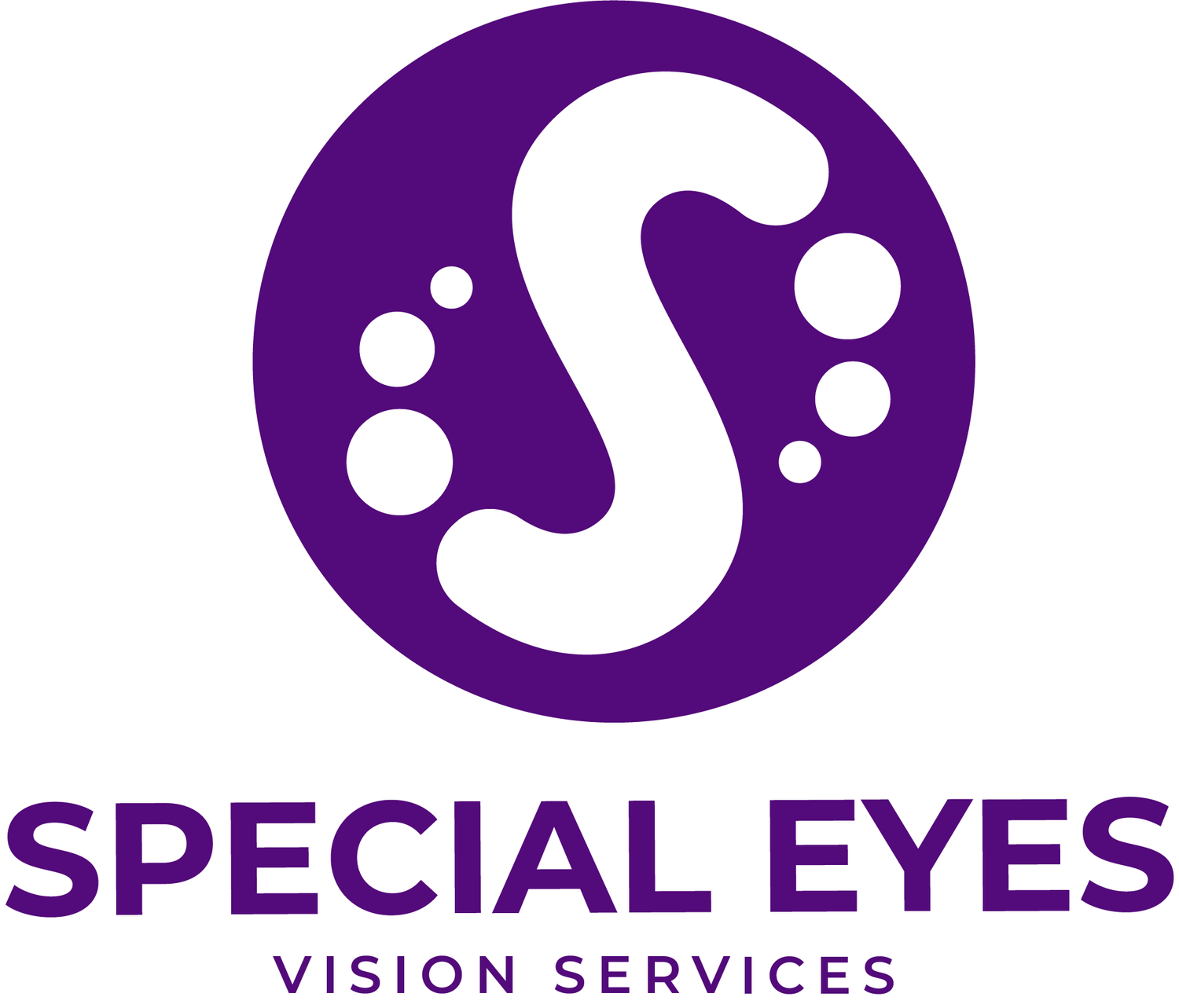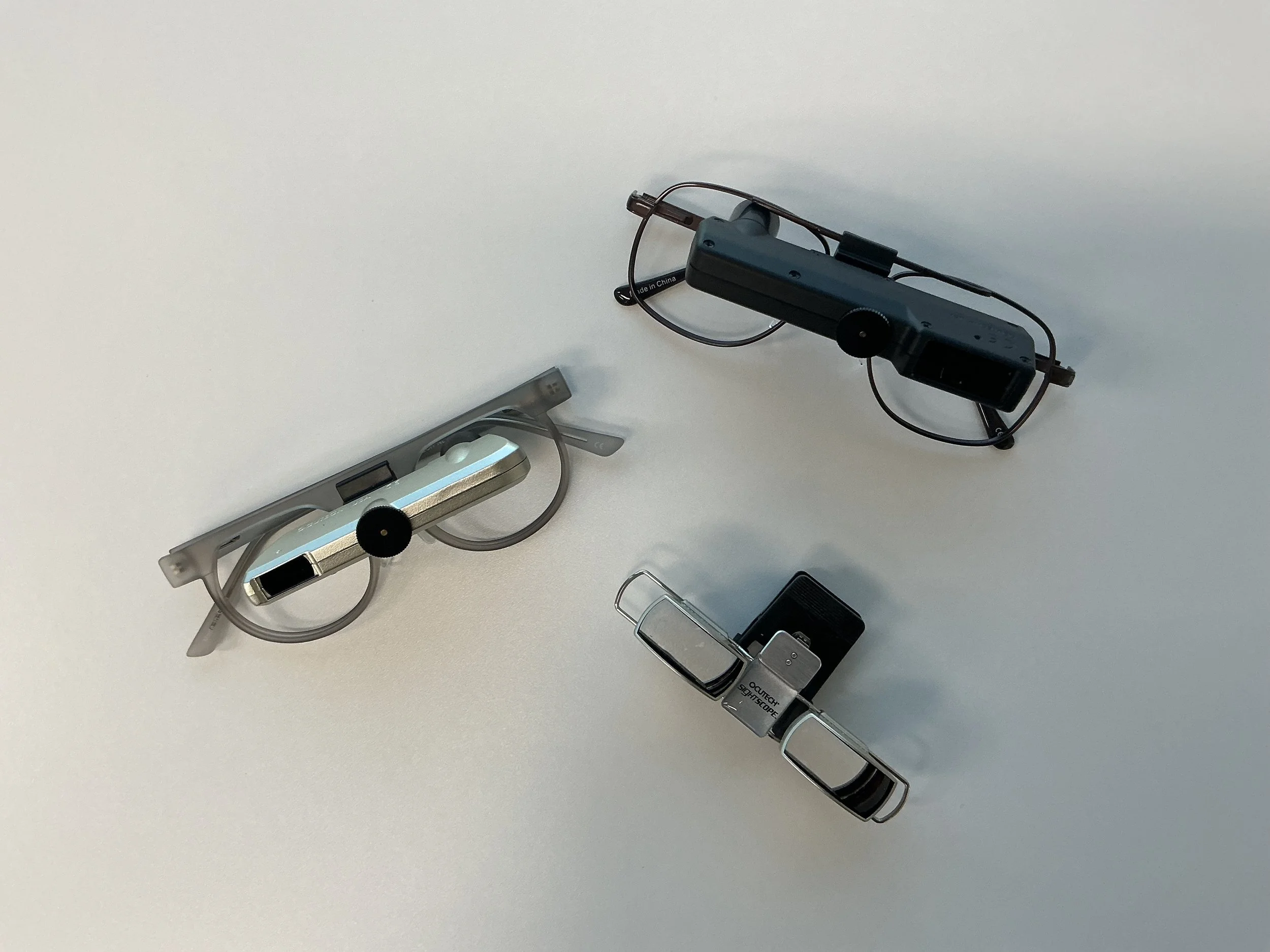Low vision devices: All about bioptics
Image of three different types of bioptic telescopes: the telescopes are approximately 8cm in length, 2cm front to back, and 1cm top to bottom. The top telescope is black and attached to a bronze avaiator-style frame. The telescope on the left is silver and is attached to a smoke-grey paediatric frame. The telescope on the bottom right clips on to a glasses frame to provide hands-free magnification through both eyes for concentrated tasks.
Introduction
If you, or someone you care about is navigating life with low vision, you will be aware of the significant challenges it can create, and the difficulties imposed on everyday activities. When faced with a challenge, it is critical to have the right tools for the job. In the case of low vision, these tools are referred to a low vision aids / low vision devices.
Bioptic telescopes are among the most versatile of low vision devices. You may not have come across bioptics, because they are not very widely available in Australia, but they are available, and they truly are amazing low vision aids. So, if you would like to learn more, read on…
What is a bioptic telescope?
Side profile of a lady wearing a silver bioptic telescope.
In simple terms, a bioptic telescope is a miniature telescope incorporated into a conventional pair of glasses. Let’s break it down a bit further.
Telescopes are a staple device for people with vision impairment, they are used to magnify things in the distance, and many can be focused to view things at closer distances too. They can be used for a wide range of tasks that involve viewing detail at distance, including reading street signs, watching sport, and identifying faces, as well as distinguishing things at closer distances, such as looking at photos and reading price labels. The downside to using a telescope is that it restricts our field of view, that is, the area we can see at any one time, and because of this, you do not look through a telescope all of the time, but rather use it for certain tasks, such as distinguishing whether the bus approaching is your bus, by reading the number on the front.
Close up image of a black bioptic telescope attached to a silver frame. You can see the objective lens on the right side and the focus knob in the centre.
In a bioptic, we have a very lightweight telescope mounted onto the top of a spectacle frame, so you can look through your regular spectacle lenses most of the time, keeping the benefits of accessing your full field of vision, and then dip your chin slightly to look through the mini telescope when you need magnification. If the user wants to check if the approaching bus is the one they are waiting for, they no longer have to dig the telescope out of a pocket or bag to check the number, because the bioptic is right there, ready to use.
How do they work?
A bioptic telescope functions like a miniaturised pair of binoculars attached to your glasses.
The lens at the front is called an objective lens. This lens collects light from the distant object and directs it into the system.
A series of prisms and mirrors inside reorient the image, so it appears the right way up and in the right place
Then there is an eyepiece lenses, which allows the eye to see the image created by the objective lens.
Some models also have a focusing knob, allowing the user to focus the device for different distance, from far distance, through to around 20-30cm.
Because the image is magnified, it allows you to see farther and in greater detail than you otherwise would. For example: if your normal vision lets you recognise a face at 2 meters, a 4x bioptic might let you do the same from 8 meters. For devices with adjustable focus, details at closer distances can also be viewed with magnification.
There are different optical designs of telescope, each with trade-offs:
Galilean telescopes are smaller and lighter, good for lower magnification (e.g., 1.7x or 2.2x) but the field of view narrows as magnification increases.
Keplerian telescopes are more complex (using prisms, etc), heavier, but offer wider fields of view at higher magnification (3x, 4x, up to 6x or more).
When prescribing a bioptic, we need to balance how much magnification is needed (to achieve a functional level of acuity) with how wide a field of view the user will tolerate — too high magnification reduces the field of view more, and can make locating things harder.
What can they be used for?
Bioptic telescopes open up a range of everyday tasks that might otherwise be challenging for people with low vision. Some tasks they are commonly used for include:
Recognising faces, seeing the expressions of friends and family, and interpreting body language.
Watching television, movies, sport, and live performances.
Reading the whiteboard in a classroom from a normal distance (rather than sitting at the front).
Shopping, hiking, cycling, travel — giving confidence in mobility.
Even driving in some cases, because the device gives the user more distance vision time to see a sign, pedestrian, or obstacle earlier.
Reading price tags and viewing items in the frozen section at the supermarket.
Reading print and using the computer.
It’s important to note that while the telescope enhances distance vision, it doesn’t replace all other aids or compensate for all vision loss. It tends to be part of a broader low-vision strategy, which might include lighting, contrast enhancements, and learning practical strategies from low vision professionals such as occupational therapists, and orientation & mobility specialists.
What eye conditions do they suit?
Bioptic telescopes are well suited to a wide range of eye condition, including (though not limited to) the following:
Albinism
Nystagmus
Achromatopsia and rod-cone dystrophy
Optic atrophy
Stargardt disease
Macular degeneration
Diabetic retinopathy
Of course, each individual’s suitability depends on many factors: residual acuity, field of view, contrast sensitivity, ocular dominance, dexterity, lifestyle needs, and whether a trained low-vision specialist is involved in prescribing and training.
What is the process to obtain a bioptic?
Because they are precision, low vision devices, assessing and fitting someone for a bioptic requires the skills of an optometrist familiar with low vision rehabilitation. At Special Eyes we have the skills and equipment to provide fitting and assessment for these devices.
Steps involved in assessment and fitting would include:
A detailed low-vision assessment to determine what level of detail can currently be seen (visual acuity), what area of vision the person can see (field of vision), ability to distinguish detail when it is not black and white (contrast sensitivity), and which eye would be best to fit the telescope in front of.
Selection of appropriate magnification (not just the highest possible) to balance acuity gain with ease of use.
Precise fitting and alignment of the telescope on the frame (which affects how intuitive it is to switch between carrier lens and telescope).
Training and practice: users are coached to “tilt the head, look through the telescope when needed, and go back to the carrier lens for general vision.” Over time it becomes more natural.
Managing expectations: While the improvement can be remarkable, limitations still apply as the field of view is narrower when looking through the telescope and magnification reduces brightness and contrast, so it may take some getting used to).
In conclusion
Bioptic telescopes can significantly increase independence across a wide range of tasks for people living with low vision. For many people, the ability to recognise a face across the room, to read a sign, to watch a play, or to drive (where permitted) can open doors to social interaction, independence, and confidence.
If you’re exploring whether a bioptic might be right for you, consider noting down your key vision-goals (What do I most want to see? Where do I struggle most?), then give us a call to arrange a no obligation, initial phone consult with Dr Ursula. Our reception is staffed 10am -2.30pm on Mondays and Thursdays. Alternatively, you can send an email and we will contact you. We are looking forward to hearing from you.
Got more questions?
Check out our FAQ’s below, or give us a call.
-
They suit individuals with stable low vision who have enough remaining vision to benefit from magnification. Conditions like macular degeneration, albinism, Stargardt’s disease, achromatopsia, and optic atrophy are common examples.
-
In some cases — yes. Bioptics can be used for driving in most parts of Australia, but there are vision requirements that must be met without the bioptic in order to be granted a licence.
-
They require training and practice, but most users adapt well. Using them becomes a quick glance through the telescope only when needed, not for constant viewing.
-
No. Bioptics don't replace regular glasses — they are an assistive device for improving distance vision tasks.
-
Most bioptics range between 2x and 6x magnification depending on the model and user needs.
-
Adjustable focus biopics can be used for shorter reading tasks, such as checking an email or reading a price-tag. There are also some types which are designed to work for more prolonged near tasks.
-
Bioptics are more noticeable than regular glasses, but modern devices are smaller, lighter, and more cosmetically appealing than older styles.
-
The bioptic telescopes we fit at Special Eyes weight around 20g, making them comfortable to wear for longer periods of time. The also come with a neoprene strap which helps keep them secure and stops them sliding forward or down your nose.
-
Yes. They are useful in classrooms, at the theatre, in shops, outdoors, and generally anywhere distance detail is needed.
-
Most users adjust within days to weeks with proper training. It’s similar to learning how to use progressives or a new mobility aid.
-
In Australia they may be funded through NDIS or low-vision support programs if clinically justified.



